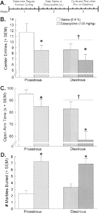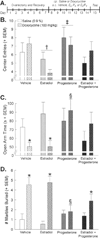Progesterone protects normative anxiety-like responding among ovariectomized female mice that conditionally express the HIV-1 regulatory protein, Tat, in the CNS
- PMID: 24726788
- PMCID: PMC4067900
- DOI: 10.1016/j.yhbeh.2014.04.001
Progesterone protects normative anxiety-like responding among ovariectomized female mice that conditionally express the HIV-1 regulatory protein, Tat, in the CNS
Abstract
Increased anxiety is co-morbid with human immunodeficiency virus (HIV) infection. Actions of the neurotoxic HIV-1 regulatory protein, Tat, may contribute to affective dysfunction. We hypothesized that Tat expression would increase anxiety-like behavior of female GT-tg bigenic mice that express HIV-1 Tat protein in the brain in a doxycycline-dependent manner. Furthermore, given reports that HIV-induced anxiety may occur at lower rates among women, and that the neurotoxic effects of Tat are ameliorated by sex steroids in vitro, we hypothesized that 17β-estradiol and/or progesterone would ameliorate Tat-induced anxiety-like effects. Among naturally-cycling proestrous and diestrous mice, Tat-induction via 7days of doxycycline treatment significantly increased anxiety-like responding in an open field, elevated plus maze and a marble-burying task, compared to treatment with saline. Proestrous mice demonstrated less anxiety-like behavior than diestrous mice in the open field and elevated plus maze, but these effects did not significantly interact with Tat-induction. Among ovariectomized mice, doxycycline-induced Tat protein significantly increased anxiety-like behavior in an elevated plus maze and a marble burying task compared to saline-treated mice, but not an open field (where anxiety-like responding was already maximal). Co-administration of progesterone (4mg/kg), but not 17β-estradiol (0.09mg/kg), with doxycycline significantly ameliorated anxiety-like responding in the elevated plus maze and marble burying tasks. When administered together, 17β-estradiol partially antagonized the protective effects of progesterone on Tat-induced anxiety-like behavior. These findings support evidence of steroid-protection over HIV-1 proteins, and extend them by demonstrating the protective capacity of progesterone on Tat-induced anxiety-like behavior of ovariectomized female mice.
Keywords: 17β-estradiol; Elevated plus maze; Estrous cycle; GT-tg bigenic mice; Marble burying; Neuroaids; Open field; Ovariectomy; Tat(1–86); Transactivating transcriptor.
Copyright © 2014 Elsevier Inc. All rights reserved.
Figures



Similar articles
-
5α-reduced progestogens ameliorate mood-related behavioral pathology, neurotoxicity, and microgliosis associated with exposure to HIV-1 Tat.Brain Behav Immun. 2016 Jul;55:202-214. doi: 10.1016/j.bbi.2016.01.007. Epub 2016 Jan 13. Brain Behav Immun. 2016. PMID: 26774528 Free PMC article.
-
Progestogens and estrogen influence impulsive burying and avoidant freezing behavior of naturally cycling and ovariectomized rats.Pharmacol Biochem Behav. 2009 Sep;93(3):337-42. doi: 10.1016/j.pbb.2009.05.003. Epub 2009 May 14. Pharmacol Biochem Behav. 2009. PMID: 19447128 Free PMC article.
-
Anxiety-like behavior of mice produced by conditional central expression of the HIV-1 regulatory protein, Tat.Psychopharmacology (Berl). 2014 Jun;231(11):2349-60. doi: 10.1007/s00213-013-3385-1. Epub 2013 Dec 19. Psychopharmacology (Berl). 2014. PMID: 24352568 Free PMC article.
-
Combined HIV-1 Tat and oxycodone activate the hypothalamic-pituitary-adrenal and -gonadal axes and promote psychomotor, affective, and cognitive dysfunction in female mice.Horm Behav. 2020 Mar;119:104649. doi: 10.1016/j.yhbeh.2019.104649. Epub 2019 Dec 13. Horm Behav. 2020. PMID: 31821792 Free PMC article.
-
Doxycycline-inducible and astrocyte-specific HIV-1 Tat transgenic mice (iTat) as an HIV/neuroAIDS model.J Neurovirol. 2018 Apr;24(2):168-179. doi: 10.1007/s13365-017-0598-9. Epub 2017 Nov 15. J Neurovirol. 2018. PMID: 29143286 Free PMC article. Review.
Cited by
-
Pregnane steroidogenesis is altered by HIV-1 Tat and morphine: Physiological allopregnanolone is protective against neurotoxic and psychomotor effects.Neurobiol Stress. 2020 Jan 29;12:100211. doi: 10.1016/j.ynstr.2020.100211. eCollection 2020 May. Neurobiol Stress. 2020. PMID: 32258256 Free PMC article.
-
Effects of acute Δ9-tetrahydrocannabinol on behavior and the endocannabinoid system in HIV-1 Tat transgenic female and male mice.Brain Res. 2024 Jan 1;1822:148638. doi: 10.1016/j.brainres.2023.148638. Epub 2023 Oct 17. Brain Res. 2024. PMID: 37858856 Free PMC article.
-
HIV-1 Tat promotes age-related cognitive, anxiety-like, and antinociceptive impairments in female mice that are moderated by aging and endocrine status.Geroscience. 2021 Feb;43(1):309-327. doi: 10.1007/s11357-020-00268-z. Epub 2020 Sep 17. Geroscience. 2021. PMID: 32940828 Free PMC article.
-
Age-related neuroendocrine, cognitive, and behavioral co-morbidities are promoted by HIV-1 Tat expression in male mice.Aging (Albany NY). 2022 Jul 12;14(13):5345-5365. doi: 10.18632/aging.204166. Epub 2022 Jul 12. Aging (Albany NY). 2022. PMID: 35830469 Free PMC article.
-
HIV-1 Tat Length: Comparative and Functional Considerations.Front Microbiol. 2020 Mar 24;11:444. doi: 10.3389/fmicb.2020.00444. eCollection 2020. Front Microbiol. 2020. PMID: 32265877 Free PMC article. No abstract available.
References
-
- Ahn SC, Kim GY, Kim JH, Baik SW, Han MK, Lee HJ, Moon DO, Lee CM, Kang JH, Kim BH, Oh YH, Park YM. Epigallocatechin-3-gallate, constituent of green tea, suppresses the LPS-induced phenotypic and functional maturation of murine dendritic cells through inhibition of mitogen-activated protein kinases and NF-kappaB. Biochem. Biophys. Res. Commun. 2004;313:148–155. - PubMed
-
- Baeten JM, Lavreys L, Sagar M, Kreiss JK, Richardson BA, Chohan B, Panteleeff D, Mandaliya K, Ndinya-Achola JO, Overbaugh J, Farley T, Mwachari C, Cohen C, Chipato T, Jaisamrarn U, Kiriwat O, Duerr A. Effect of contraceptive methods on natural history of HIV: studies from the Mombasa cohort. J. Acquir. Immune Defic. Syndr. 2005;38:S18–S21. - PubMed
-
- Bali A, Jaggi AS. Multifunctional aspects of allopregnanolone in stress and related disorders. Prog. Neuropsychopharmacol. Biol. Psychiatry. 2013;48C:64–78. - PubMed
Publication types
MeSH terms
Substances
Grants and funding
LinkOut - more resources
Full Text Sources
Other Literature Sources
Medical
Miscellaneous

